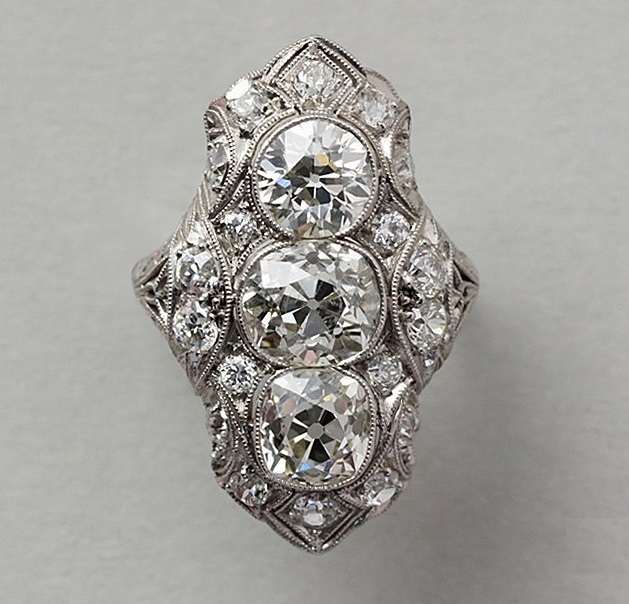Through much of its history platinum has intrigued, baffled, flummoxed and fascinated scientists and alchemists until this noble metal was finally tamed at the turn of the 20th century. Since that time it has become a favored precious metal used in some of the finest jewelry.
The first platinum discoveries were found 3,000 years ago in ancient Egypt. Traces of platinum were found in gold that was used in caskets in Thebes, which archeologists believe was a natural element in the gold that came from Nubia at that time. Meanwhile, half way around the world, the South Americans were creating ceremonial jewelry and objects for ritual use out of platinum (probably mixed with an alloy) that can be dated back to 100 B.C.
Platinum and the Conquistadors
Platinum didn’t really get much play until the 1500’s when the Spanish conquistadors landed in South America searching for gold. Instead they found platinum, but they thought it was silver and tossed it aside. The conquistadors named this new metal “platina del Pinto” — little silver of Pinto river, which is the name of the river in Colombia where the platinum was found.
In 1557, Julius Caesar Scaliger, an Italian-French scientist analyzed a bit of the mystery metal from South America and found that it was not silver and that it wouldn’t melt. According to some scientists, Scaliger was the first to make any written mention of platinum. Not too much happened with platinum until the 1700s because no one really knew what to do with it. The high melting point of 3,214 degrees Fahrenheit (for comparison, gold has a melting point of 1,947 degrees Fahrenheit) made it difficult if not impossible to work with the metal.
A Platinum Expedition

In the 1740s, Antonio de Ulloa, a Spanish scientist went on an expedition to South America. When he returned to Spain, de Ulloa described platinum and the challenges that the metal presents. During the same decade, Charles Wood, a Jamaican metallurgist studied platinum even smuggling some of the metal into England. He continued his experiments with platinum and came to the conclusion that it was a new metal. In 1750, Wood presented his evidence to the Royal Society of England.
Wood’s findings were supported by a Swedish scientist Henrik Teofilus Scheffer, who in 1751 presented a paper to the Swedish Academy of Sciences, once more describing the difficulty of working with platinum, but more Importantly identifying it as a precious metal.
Platinum was making news and getting all kinds of attention including from France’s King Louis XV, who announced that it was the only metal fit for a king. This of course, sparked more interest in this intriguing metal. Scientists, alchemists and metallurgists were all focused on one thing: How to make platinum melt. Finally, in the latter half of the 1700’s some scientists figured out how to make very small amounts of the metal liquify. While not a definitive answer at the time, it was a step in the right direction.
The Platinum Age of Spain
Meanwhile, King Charles III of Spain, created a lab for French chemist Pierre-Françoise Chabaneau, who is widely credited as being the first person to figure out how to make platinum malleable enough to use. Chabaneau managed to remove trace elements from platinum and by 1786 he had figured out how to make platinum malleable. King Charles III, however, made sure that the information stayed in Spain, by issuing a royal order that the process was to remain secret. This event debuted the Platinum Age of Spain, during which time malleable platinum was produced in some quantity and sold. This went on until the Napoleonic Wars in 1808, which shut down the industry in Spain.
However, some big steps forward had occurred for platinum. King Charles III commissioned a platinum chalice for Pope Pius VI, which was presented to him in 1789. At the same time the jeweler for King Louis XVI, Marc-Ettienne Janety acquired some malleable platinum from Chabaneau and used it to make buttons, watch chains and other small items.
In 1804, two British chemists, Smithson Tennant and William Hyde Wollaston, figured out how to make larger quantities of platinum malleable. This allowed jewelers to create small, simple pieces of jewelry such as cufflinks. By the end of the 1890’s, Tiffany & Co. and Cartier Paris were both creating jewelry using platinum as was Fabergé.
High heat blow torches became available in the early 20th century that gave jewelers the ability to create lacy, lightweight intricate jewelry from this most precious metal. The white metal was the perfect complement to the white on white look of diamonds and pearls that was the height of fashion in the Edwardian era. Platinum retained its popularity throughout the Art Deco era, but its use in jewelry came to a halt when it was declared a strategic metal and reserved for military use during World War II.
Platinum had a resurgence of popularity in the 1950s when formal jewelry was the style. It fell out of favor during the next three decades and then in the 1990s platinum made a comeback, mainly in bridal and continues to be on trend today, especially in high jewelry.
All jewelry featured in this blog can be found on The Jewelers Circle.
Featured image (top of page): Aquamarine, diamond and platinum brooch, circa 1935, courtesy L’Epoque D’Or.
Authored by Amber Michelle

